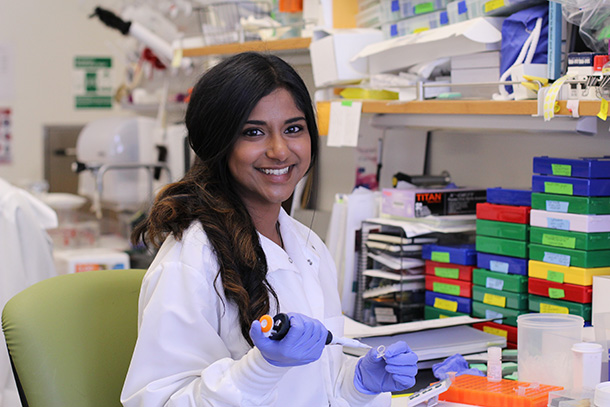“Everyone in this audience right now, you all started out as a stem cell,” said Natasha Natarajan at the 2017 TEDxUSC conference. “And then your DNA came in, did all the work, and differentiated each group of your stem cells into your muscles, into your heart, into your brain until we get the finished product: you.”
Natarajan’s eyes sparkled as she described the potential of stem cell research — which has been a passion of hers since she was 15 years old. As a high school student taking Advanced Placement Biology at Beverly Hills High School, she won a writing competition about stem cells hosted by Cedars-Sinai Medical Center. Her prize was the opportunity to work in the UCLA laboratory of Jianyu Rao, MD, who was studying how green tea affects stem cells.
“I’m kind of a stem cell geek,” Natarajan said. “I’m really into it.”
When it came time to apply to college, Natarajan was excited to learn about the Eli and Edythe Broad Center for Regenerative Medicine and Stem Cell Research at USC — a university that already held a special place in her heart.
“My mom did her surgical pathology fellowship at USC, and my dad was a surgeon at USC,” she said. “That’s how they met. He sent her some slides, and she said, ‘It’s not benign.’ And then they had a little argument. And of course, he is really attracted to strong females who contradict him!”
Natarajan’s oldest sister and older brother both attended USC as undergraduates, and her older brother is now pursuing both his MD and master of public health degrees at the Keck School of Medicine of USC.
“We’re a big Trojan family,” said Natarajan, who graduated from USC with her bachelor’s degree in human biology, and is now pursuing a progressive master’s degree in stem cell biology and regenerative medicine.
She made her first foray into stem cells at USC with the course MEDS 380 Stem Cells: Fact or Fiction. During the course, Gage Crump, PhD, associate professor of stem cell biology and regenerative medicine, led strange and spirited discussions about stem cells in film, literature and the laboratory.
Newly inspired, she joined the Crump Lab, where she has spent two-and-half years working with postdoctoral scholar – research associate Joanna Smeeton, PhD, to understand how zebrafish regenerate their damaged, arthritic joints.
In addition to participating in medical research during her undergraduate years, Natarajan studied abroad in Oxford, England, and Cape Town, South Africa.
“My dad is actually the first Indian surgeon from Johannesburg,” she said. “He left during apartheid. So it was a lot of struggle for him to even become a surgeon. And once he was a surgeon, the system kept not allowing him to achieve. So USC made him an offer, and he moved to the U.S. I did some volunteering and shadowing in a hospital in South Africa, and it gave me a lot more context for what it must have been like for my dad to do all of that.”
Back on campus, she continued to pursue her interest in medicine as co-editor-in-chief of The Healing Process, a magazine that explores health and well-being through the lens of art and literature. Under her leadership, the magazine has featured a sculpture inspired by the research of USC Stem Cell scientist Neil Segil, PhD, professor of research stem cell biology and regenerative medicine, as well as stem cell microscopy by PhD student Camilla Teng from the Crump Lab.
In recognition of her many undergraduate achievements, Natarajan graduated as one of six 2017 Dornsife Scholars. This $10,000 prize honors undergraduates who combine academic excellence in the letters, arts, and sciences with the aspiration to have a positive impact on the world.
After completing her progressive master’s degree in stem cell biology and regenerative medicine, Natarajan intends to amplify her positive impact by pursuing medical school: “Being a physician is a priority to me, and stem cells are a passion. I want to be a doctor that uses these innovative stem cell therapies and actually implements them in patients.”
— Cristy Lytal


